TAXATION LAW 13 - Taxation Law Assignment, Semester 2, Uni Name
VerifiedAdded on 2020/02/18
|15
|3391
|337
Homework Assignment
AI Summary
This Taxation Law assignment provides a comprehensive overview of Australian taxation principles. It begins with an analysis of the sources of Commonwealth parliament's taxation powers, including relevant sections of the Australian Constitution. The assignment then delves into primary sources of tax law, including case laws and taxation rulings. Key concepts like residency tests, Medicare levy calculations, and the Competition and Consumer Act are explored. The assignment further addresses deductions for losses from theft, repair costs, and stock valuation methods. It includes calculations of tax payable based on income levels and explains the PAYG system. Part B discusses allowable deductions under Division 8 of the ITAA 1997, while Part C examines residency tests. Part D focuses on assessable income, differentiating between ordinary and statutory income. Finally, the assignment provides answers to a series of questions on various aspects of Australian tax law, offering practical examples and case studies.
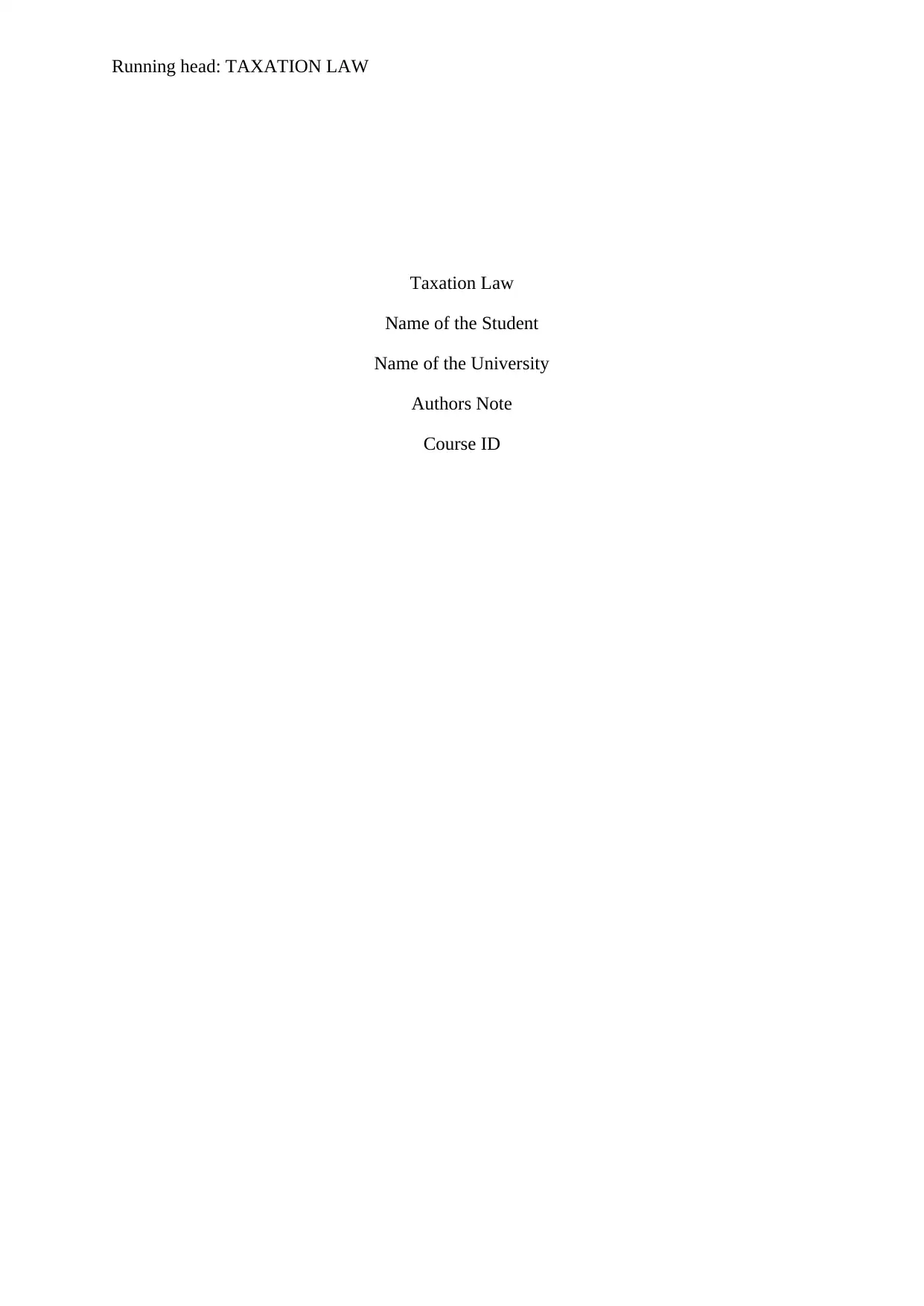
Running head: TAXATION LAW
Taxation Law
Name of the Student
Name of the University
Authors Note
Course ID
Taxation Law
Name of the Student
Name of the University
Authors Note
Course ID
Paraphrase This Document
Need a fresh take? Get an instant paraphrase of this document with our AI Paraphraser
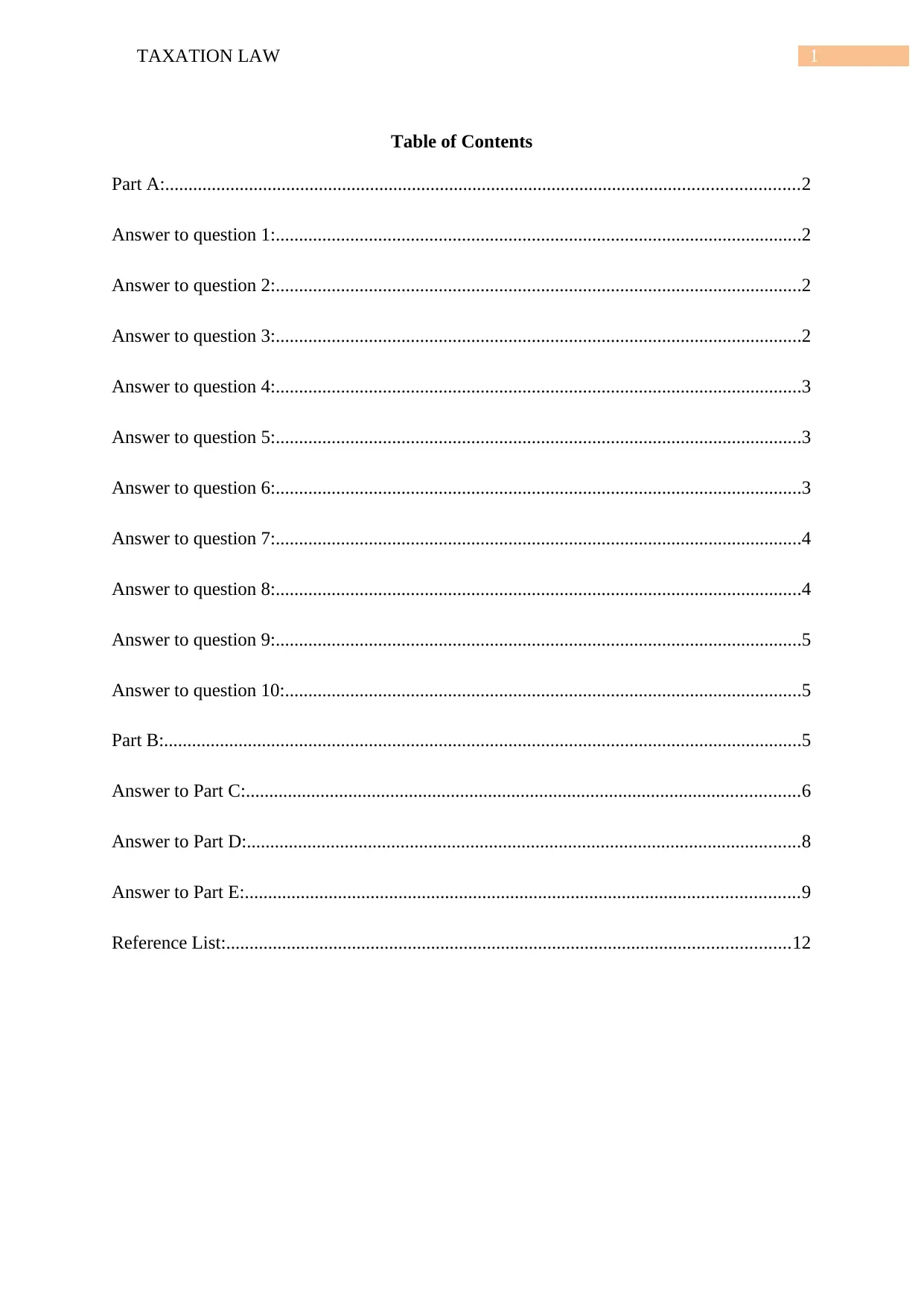
1TAXATION LAW
Table of Contents
Part A:........................................................................................................................................2
Answer to question 1:.................................................................................................................2
Answer to question 2:.................................................................................................................2
Answer to question 3:.................................................................................................................2
Answer to question 4:.................................................................................................................3
Answer to question 5:.................................................................................................................3
Answer to question 6:.................................................................................................................3
Answer to question 7:.................................................................................................................4
Answer to question 8:.................................................................................................................4
Answer to question 9:.................................................................................................................5
Answer to question 10:...............................................................................................................5
Part B:.........................................................................................................................................5
Answer to Part C:.......................................................................................................................6
Answer to Part D:.......................................................................................................................8
Answer to Part E:.......................................................................................................................9
Reference List:.........................................................................................................................12
Table of Contents
Part A:........................................................................................................................................2
Answer to question 1:.................................................................................................................2
Answer to question 2:.................................................................................................................2
Answer to question 3:.................................................................................................................2
Answer to question 4:.................................................................................................................3
Answer to question 5:.................................................................................................................3
Answer to question 6:.................................................................................................................3
Answer to question 7:.................................................................................................................4
Answer to question 8:.................................................................................................................4
Answer to question 9:.................................................................................................................5
Answer to question 10:...............................................................................................................5
Part B:.........................................................................................................................................5
Answer to Part C:.......................................................................................................................6
Answer to Part D:.......................................................................................................................8
Answer to Part E:.......................................................................................................................9
Reference List:.........................................................................................................................12
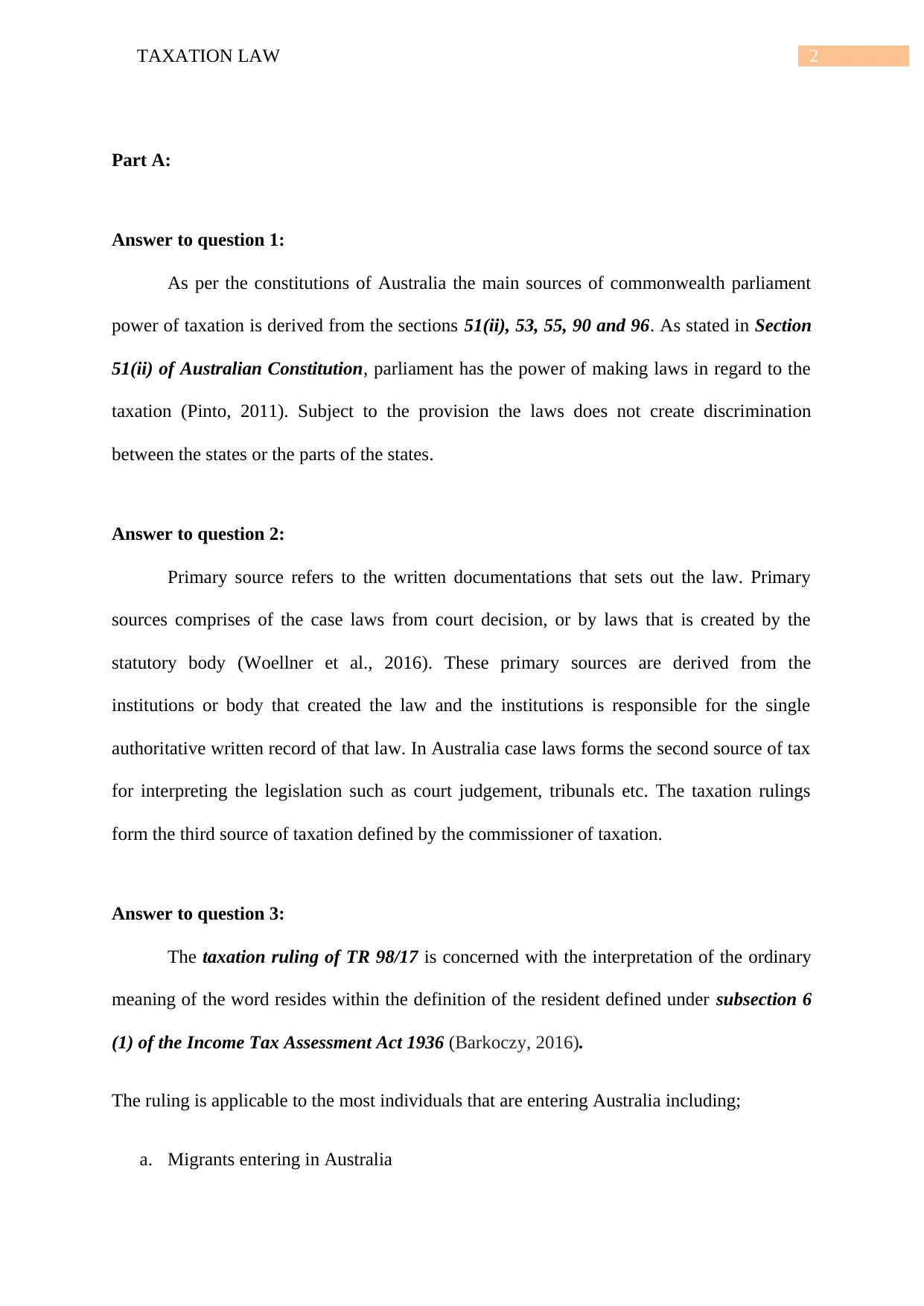
2TAXATION LAW
Part A:
Answer to question 1:
As per the constitutions of Australia the main sources of commonwealth parliament
power of taxation is derived from the sections 51(ii), 53, 55, 90 and 96. As stated in Section
51(ii) of Australian Constitution, parliament has the power of making laws in regard to the
taxation (Pinto, 2011). Subject to the provision the laws does not create discrimination
between the states or the parts of the states.
Answer to question 2:
Primary source refers to the written documentations that sets out the law. Primary
sources comprises of the case laws from court decision, or by laws that is created by the
statutory body (Woellner et al., 2016). These primary sources are derived from the
institutions or body that created the law and the institutions is responsible for the single
authoritative written record of that law. In Australia case laws forms the second source of tax
for interpreting the legislation such as court judgement, tribunals etc. The taxation rulings
form the third source of taxation defined by the commissioner of taxation.
Answer to question 3:
The taxation ruling of TR 98/17 is concerned with the interpretation of the ordinary
meaning of the word resides within the definition of the resident defined under subsection 6
(1) of the Income Tax Assessment Act 1936 (Barkoczy, 2016).
The ruling is applicable to the most individuals that are entering Australia including;
a. Migrants entering in Australia
Part A:
Answer to question 1:
As per the constitutions of Australia the main sources of commonwealth parliament
power of taxation is derived from the sections 51(ii), 53, 55, 90 and 96. As stated in Section
51(ii) of Australian Constitution, parliament has the power of making laws in regard to the
taxation (Pinto, 2011). Subject to the provision the laws does not create discrimination
between the states or the parts of the states.
Answer to question 2:
Primary source refers to the written documentations that sets out the law. Primary
sources comprises of the case laws from court decision, or by laws that is created by the
statutory body (Woellner et al., 2016). These primary sources are derived from the
institutions or body that created the law and the institutions is responsible for the single
authoritative written record of that law. In Australia case laws forms the second source of tax
for interpreting the legislation such as court judgement, tribunals etc. The taxation rulings
form the third source of taxation defined by the commissioner of taxation.
Answer to question 3:
The taxation ruling of TR 98/17 is concerned with the interpretation of the ordinary
meaning of the word resides within the definition of the resident defined under subsection 6
(1) of the Income Tax Assessment Act 1936 (Barkoczy, 2016).
The ruling is applicable to the most individuals that are entering Australia including;
a. Migrants entering in Australia
⊘ This is a preview!⊘
Do you want full access?
Subscribe today to unlock all pages.

Trusted by 1+ million students worldwide
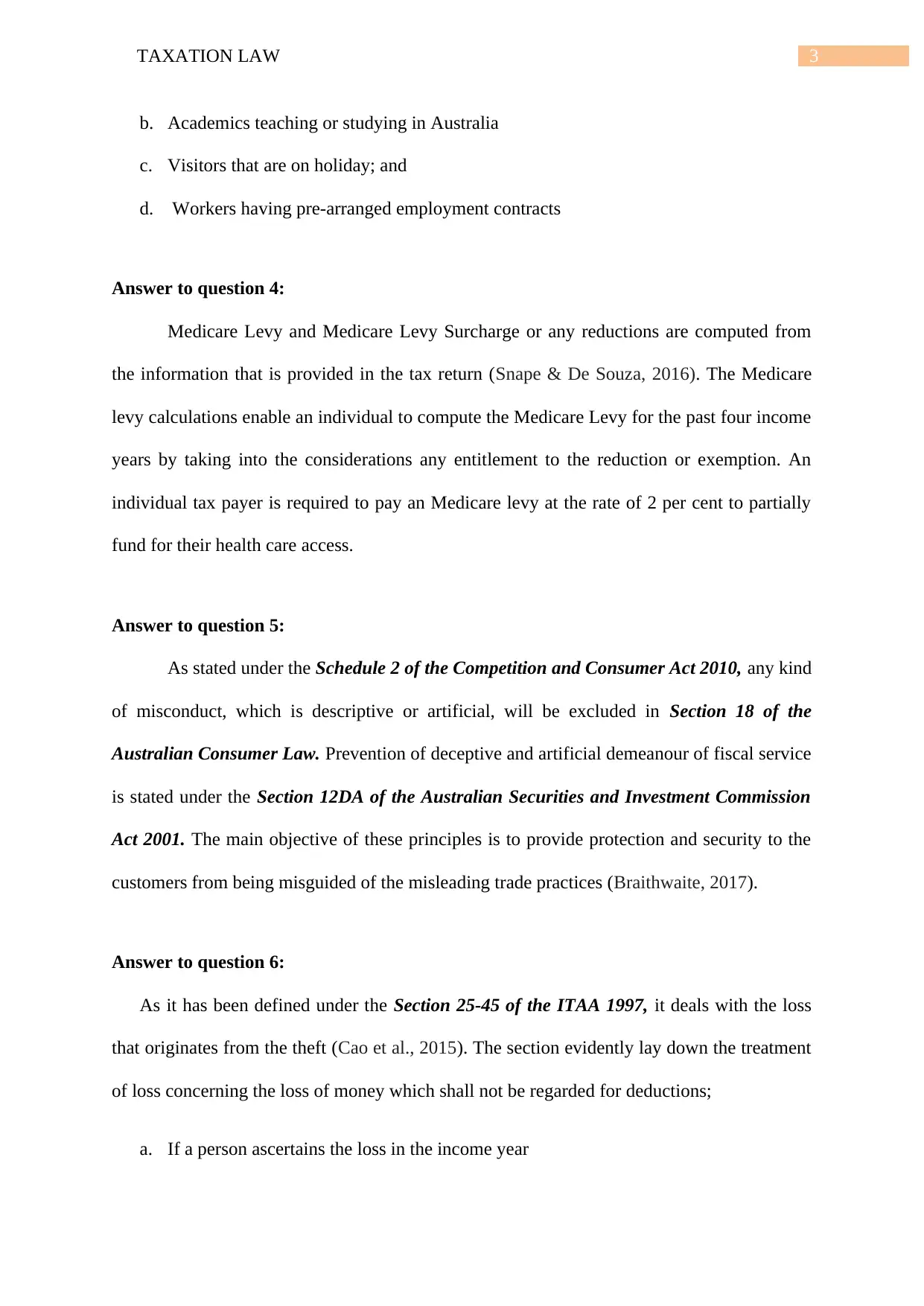
3TAXATION LAW
b. Academics teaching or studying in Australia
c. Visitors that are on holiday; and
d. Workers having pre-arranged employment contracts
Answer to question 4:
Medicare Levy and Medicare Levy Surcharge or any reductions are computed from
the information that is provided in the tax return (Snape & De Souza, 2016). The Medicare
levy calculations enable an individual to compute the Medicare Levy for the past four income
years by taking into the considerations any entitlement to the reduction or exemption. An
individual tax payer is required to pay an Medicare levy at the rate of 2 per cent to partially
fund for their health care access.
Answer to question 5:
As stated under the Schedule 2 of the Competition and Consumer Act 2010, any kind
of misconduct, which is descriptive or artificial, will be excluded in Section 18 of the
Australian Consumer Law. Prevention of deceptive and artificial demeanour of fiscal service
is stated under the Section 12DA of the Australian Securities and Investment Commission
Act 2001. The main objective of these principles is to provide protection and security to the
customers from being misguided of the misleading trade practices (Braithwaite, 2017).
Answer to question 6:
As it has been defined under the Section 25-45 of the ITAA 1997, it deals with the loss
that originates from the theft (Cao et al., 2015). The section evidently lay down the treatment
of loss concerning the loss of money which shall not be regarded for deductions;
a. If a person ascertains the loss in the income year
b. Academics teaching or studying in Australia
c. Visitors that are on holiday; and
d. Workers having pre-arranged employment contracts
Answer to question 4:
Medicare Levy and Medicare Levy Surcharge or any reductions are computed from
the information that is provided in the tax return (Snape & De Souza, 2016). The Medicare
levy calculations enable an individual to compute the Medicare Levy for the past four income
years by taking into the considerations any entitlement to the reduction or exemption. An
individual tax payer is required to pay an Medicare levy at the rate of 2 per cent to partially
fund for their health care access.
Answer to question 5:
As stated under the Schedule 2 of the Competition and Consumer Act 2010, any kind
of misconduct, which is descriptive or artificial, will be excluded in Section 18 of the
Australian Consumer Law. Prevention of deceptive and artificial demeanour of fiscal service
is stated under the Section 12DA of the Australian Securities and Investment Commission
Act 2001. The main objective of these principles is to provide protection and security to the
customers from being misguided of the misleading trade practices (Braithwaite, 2017).
Answer to question 6:
As it has been defined under the Section 25-45 of the ITAA 1997, it deals with the loss
that originates from the theft (Cao et al., 2015). The section evidently lay down the treatment
of loss concerning the loss of money which shall not be regarded for deductions;
a. If a person ascertains the loss in the income year
Paraphrase This Document
Need a fresh take? Get an instant paraphrase of this document with our AI Paraphraser
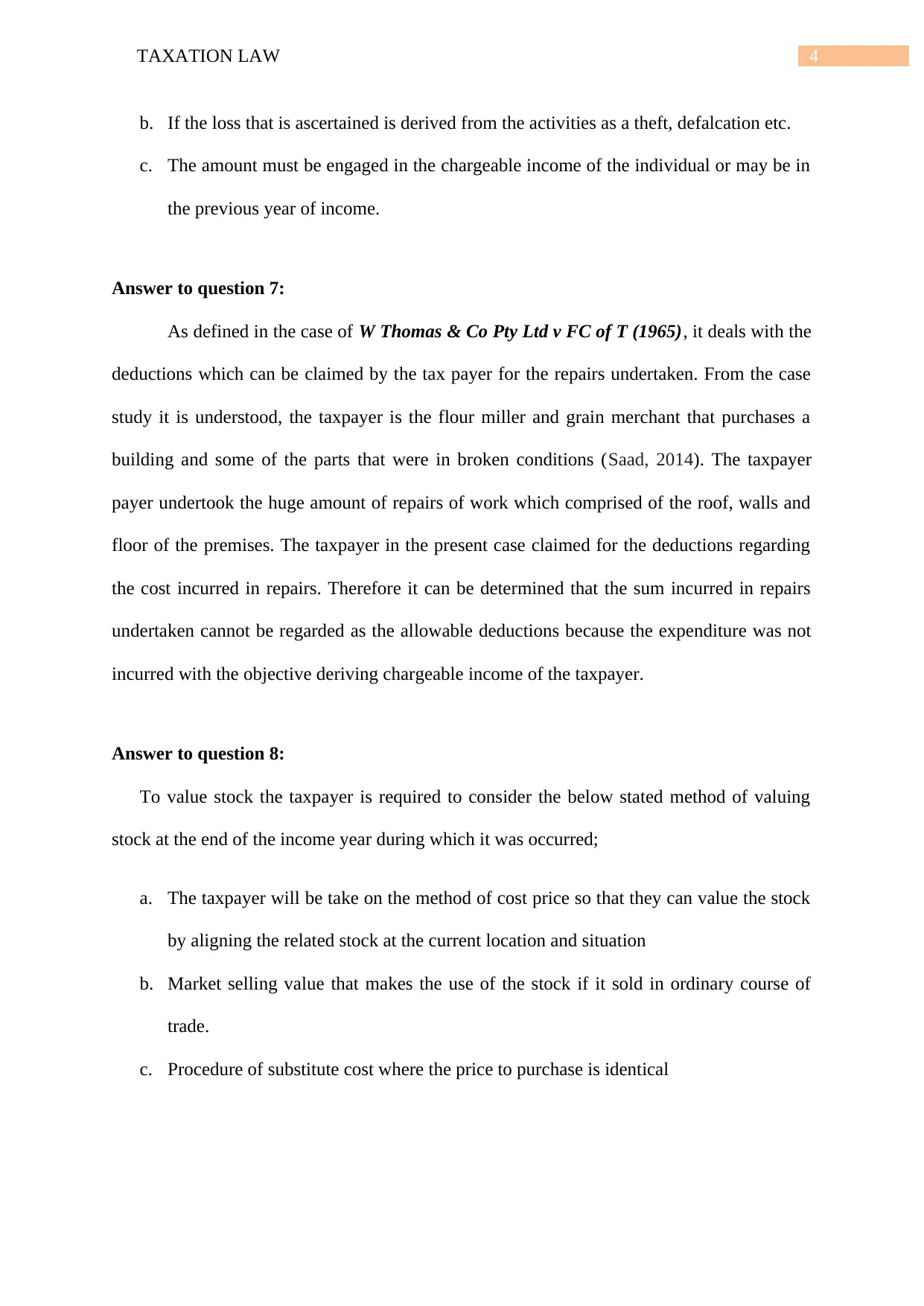
4TAXATION LAW
b. If the loss that is ascertained is derived from the activities as a theft, defalcation etc.
c. The amount must be engaged in the chargeable income of the individual or may be in
the previous year of income.
Answer to question 7:
As defined in the case of W Thomas & Co Pty Ltd v FC of T (1965), it deals with the
deductions which can be claimed by the tax payer for the repairs undertaken. From the case
study it is understood, the taxpayer is the flour miller and grain merchant that purchases a
building and some of the parts that were in broken conditions (Saad, 2014). The taxpayer
payer undertook the huge amount of repairs of work which comprised of the roof, walls and
floor of the premises. The taxpayer in the present case claimed for the deductions regarding
the cost incurred in repairs. Therefore it can be determined that the sum incurred in repairs
undertaken cannot be regarded as the allowable deductions because the expenditure was not
incurred with the objective deriving chargeable income of the taxpayer.
Answer to question 8:
To value stock the taxpayer is required to consider the below stated method of valuing
stock at the end of the income year during which it was occurred;
a. The taxpayer will be take on the method of cost price so that they can value the stock
by aligning the related stock at the current location and situation
b. Market selling value that makes the use of the stock if it sold in ordinary course of
trade.
c. Procedure of substitute cost where the price to purchase is identical
b. If the loss that is ascertained is derived from the activities as a theft, defalcation etc.
c. The amount must be engaged in the chargeable income of the individual or may be in
the previous year of income.
Answer to question 7:
As defined in the case of W Thomas & Co Pty Ltd v FC of T (1965), it deals with the
deductions which can be claimed by the tax payer for the repairs undertaken. From the case
study it is understood, the taxpayer is the flour miller and grain merchant that purchases a
building and some of the parts that were in broken conditions (Saad, 2014). The taxpayer
payer undertook the huge amount of repairs of work which comprised of the roof, walls and
floor of the premises. The taxpayer in the present case claimed for the deductions regarding
the cost incurred in repairs. Therefore it can be determined that the sum incurred in repairs
undertaken cannot be regarded as the allowable deductions because the expenditure was not
incurred with the objective deriving chargeable income of the taxpayer.
Answer to question 8:
To value stock the taxpayer is required to consider the below stated method of valuing
stock at the end of the income year during which it was occurred;
a. The taxpayer will be take on the method of cost price so that they can value the stock
by aligning the related stock at the current location and situation
b. Market selling value that makes the use of the stock if it sold in ordinary course of
trade.
c. Procedure of substitute cost where the price to purchase is identical
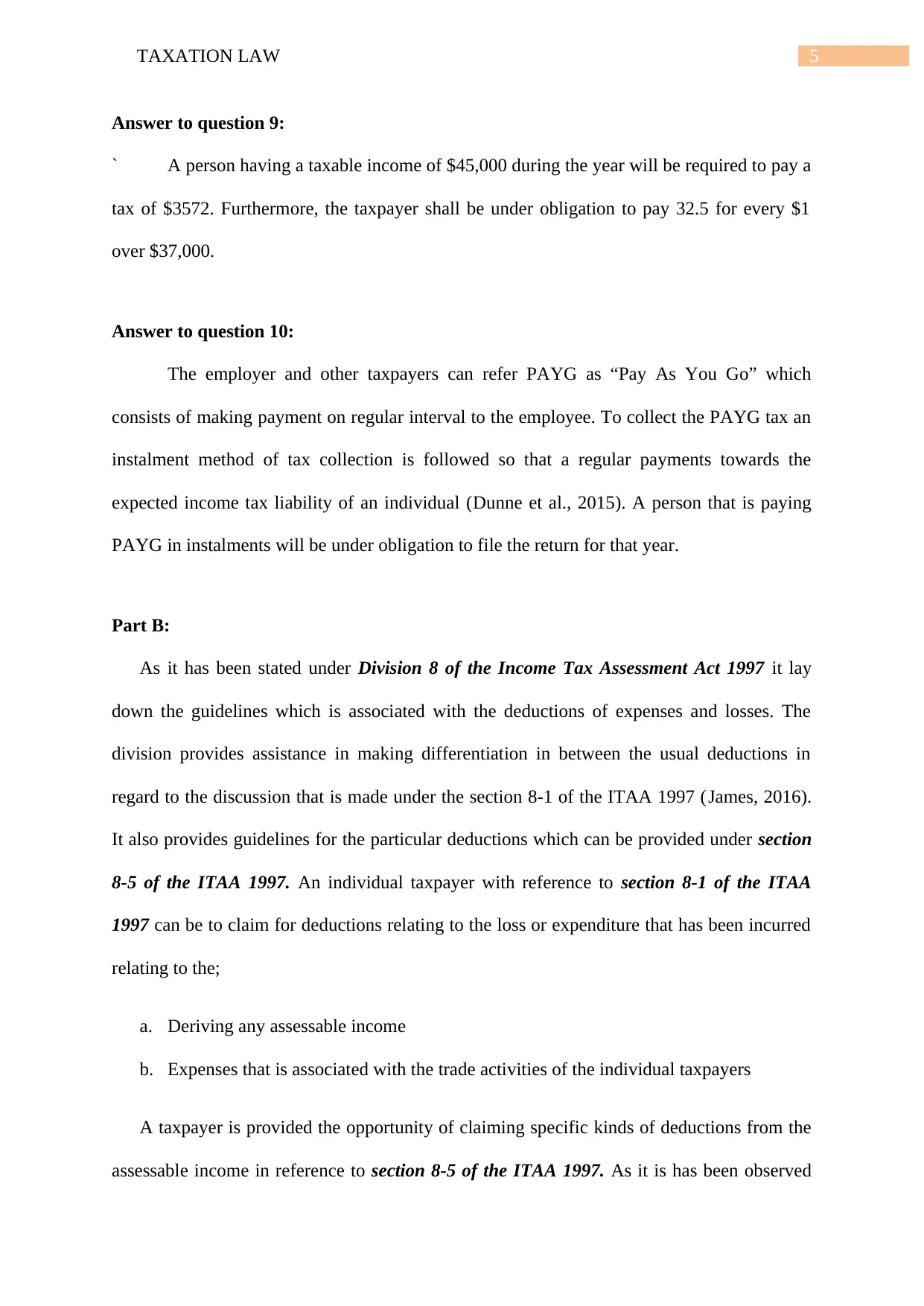
5TAXATION LAW
Answer to question 9:
` A person having a taxable income of $45,000 during the year will be required to pay a
tax of $3572. Furthermore, the taxpayer shall be under obligation to pay 32.5 for every $1
over $37,000.
Answer to question 10:
The employer and other taxpayers can refer PAYG as “Pay As You Go” which
consists of making payment on regular interval to the employee. To collect the PAYG tax an
instalment method of tax collection is followed so that a regular payments towards the
expected income tax liability of an individual (Dunne et al., 2015). A person that is paying
PAYG in instalments will be under obligation to file the return for that year.
Part B:
As it has been stated under Division 8 of the Income Tax Assessment Act 1997 it lay
down the guidelines which is associated with the deductions of expenses and losses. The
division provides assistance in making differentiation in between the usual deductions in
regard to the discussion that is made under the section 8-1 of the ITAA 1997 (James, 2016).
It also provides guidelines for the particular deductions which can be provided under section
8-5 of the ITAA 1997. An individual taxpayer with reference to section 8-1 of the ITAA
1997 can be to claim for deductions relating to the loss or expenditure that has been incurred
relating to the;
a. Deriving any assessable income
b. Expenses that is associated with the trade activities of the individual taxpayers
A taxpayer is provided the opportunity of claiming specific kinds of deductions from the
assessable income in reference to section 8-5 of the ITAA 1997. As it is has been observed
Answer to question 9:
` A person having a taxable income of $45,000 during the year will be required to pay a
tax of $3572. Furthermore, the taxpayer shall be under obligation to pay 32.5 for every $1
over $37,000.
Answer to question 10:
The employer and other taxpayers can refer PAYG as “Pay As You Go” which
consists of making payment on regular interval to the employee. To collect the PAYG tax an
instalment method of tax collection is followed so that a regular payments towards the
expected income tax liability of an individual (Dunne et al., 2015). A person that is paying
PAYG in instalments will be under obligation to file the return for that year.
Part B:
As it has been stated under Division 8 of the Income Tax Assessment Act 1997 it lay
down the guidelines which is associated with the deductions of expenses and losses. The
division provides assistance in making differentiation in between the usual deductions in
regard to the discussion that is made under the section 8-1 of the ITAA 1997 (James, 2016).
It also provides guidelines for the particular deductions which can be provided under section
8-5 of the ITAA 1997. An individual taxpayer with reference to section 8-1 of the ITAA
1997 can be to claim for deductions relating to the loss or expenditure that has been incurred
relating to the;
a. Deriving any assessable income
b. Expenses that is associated with the trade activities of the individual taxpayers
A taxpayer is provided the opportunity of claiming specific kinds of deductions from the
assessable income in reference to section 8-5 of the ITAA 1997. As it is has been observed
⊘ This is a preview!⊘
Do you want full access?
Subscribe today to unlock all pages.

Trusted by 1+ million students worldwide
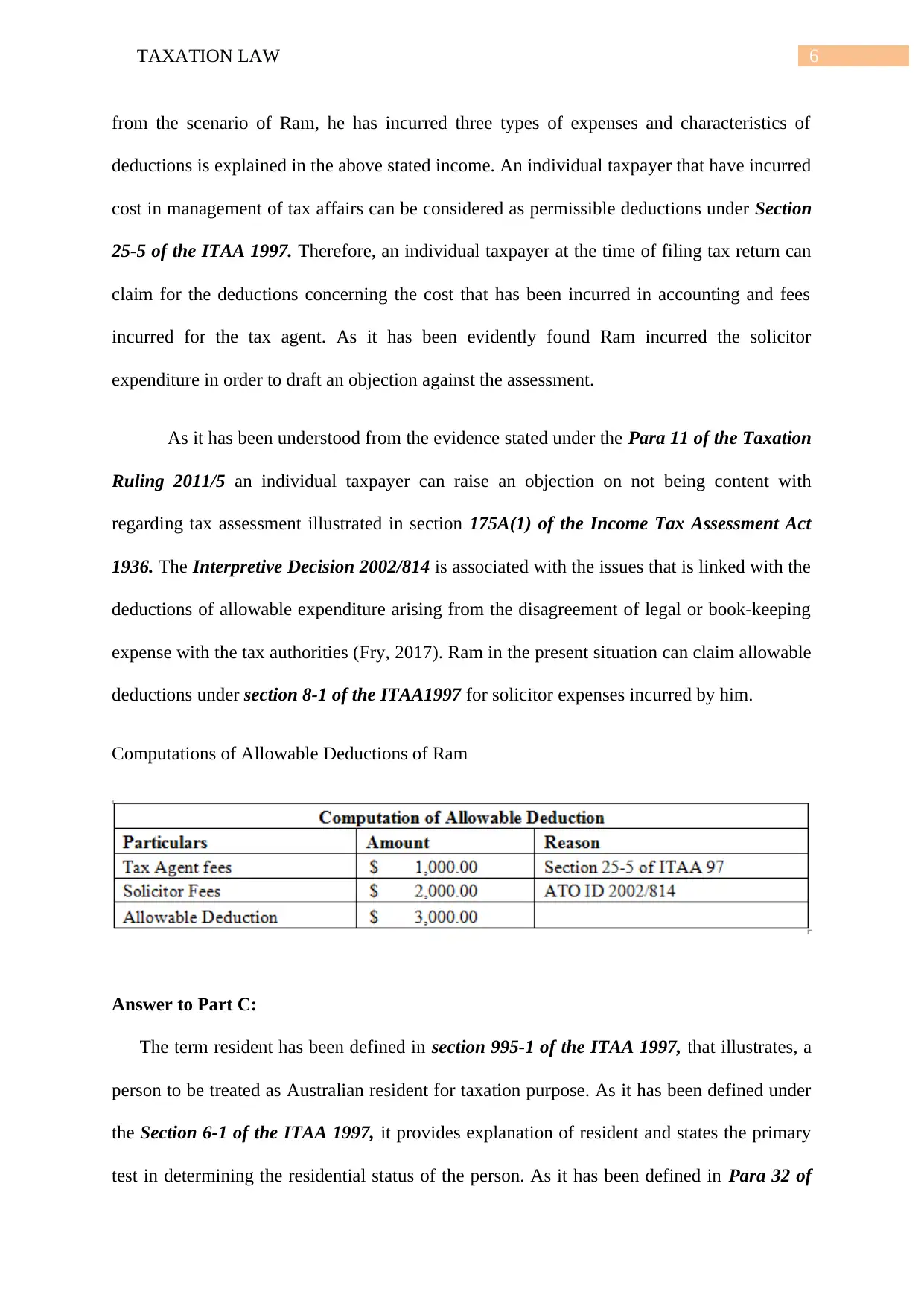
6TAXATION LAW
from the scenario of Ram, he has incurred three types of expenses and characteristics of
deductions is explained in the above stated income. An individual taxpayer that have incurred
cost in management of tax affairs can be considered as permissible deductions under Section
25-5 of the ITAA 1997. Therefore, an individual taxpayer at the time of filing tax return can
claim for the deductions concerning the cost that has been incurred in accounting and fees
incurred for the tax agent. As it has been evidently found Ram incurred the solicitor
expenditure in order to draft an objection against the assessment.
As it has been understood from the evidence stated under the Para 11 of the Taxation
Ruling 2011/5 an individual taxpayer can raise an objection on not being content with
regarding tax assessment illustrated in section 175A(1) of the Income Tax Assessment Act
1936. The Interpretive Decision 2002/814 is associated with the issues that is linked with the
deductions of allowable expenditure arising from the disagreement of legal or book-keeping
expense with the tax authorities (Fry, 2017). Ram in the present situation can claim allowable
deductions under section 8-1 of the ITAA1997 for solicitor expenses incurred by him.
Computations of Allowable Deductions of Ram
Answer to Part C:
The term resident has been defined in section 995-1 of the ITAA 1997, that illustrates, a
person to be treated as Australian resident for taxation purpose. As it has been defined under
the Section 6-1 of the ITAA 1997, it provides explanation of resident and states the primary
test in determining the residential status of the person. As it has been defined in Para 32 of
from the scenario of Ram, he has incurred three types of expenses and characteristics of
deductions is explained in the above stated income. An individual taxpayer that have incurred
cost in management of tax affairs can be considered as permissible deductions under Section
25-5 of the ITAA 1997. Therefore, an individual taxpayer at the time of filing tax return can
claim for the deductions concerning the cost that has been incurred in accounting and fees
incurred for the tax agent. As it has been evidently found Ram incurred the solicitor
expenditure in order to draft an objection against the assessment.
As it has been understood from the evidence stated under the Para 11 of the Taxation
Ruling 2011/5 an individual taxpayer can raise an objection on not being content with
regarding tax assessment illustrated in section 175A(1) of the Income Tax Assessment Act
1936. The Interpretive Decision 2002/814 is associated with the issues that is linked with the
deductions of allowable expenditure arising from the disagreement of legal or book-keeping
expense with the tax authorities (Fry, 2017). Ram in the present situation can claim allowable
deductions under section 8-1 of the ITAA1997 for solicitor expenses incurred by him.
Computations of Allowable Deductions of Ram
Answer to Part C:
The term resident has been defined in section 995-1 of the ITAA 1997, that illustrates, a
person to be treated as Australian resident for taxation purpose. As it has been defined under
the Section 6-1 of the ITAA 1997, it provides explanation of resident and states the primary
test in determining the residential status of the person. As it has been defined in Para 32 of
Paraphrase This Document
Need a fresh take? Get an instant paraphrase of this document with our AI Paraphraser
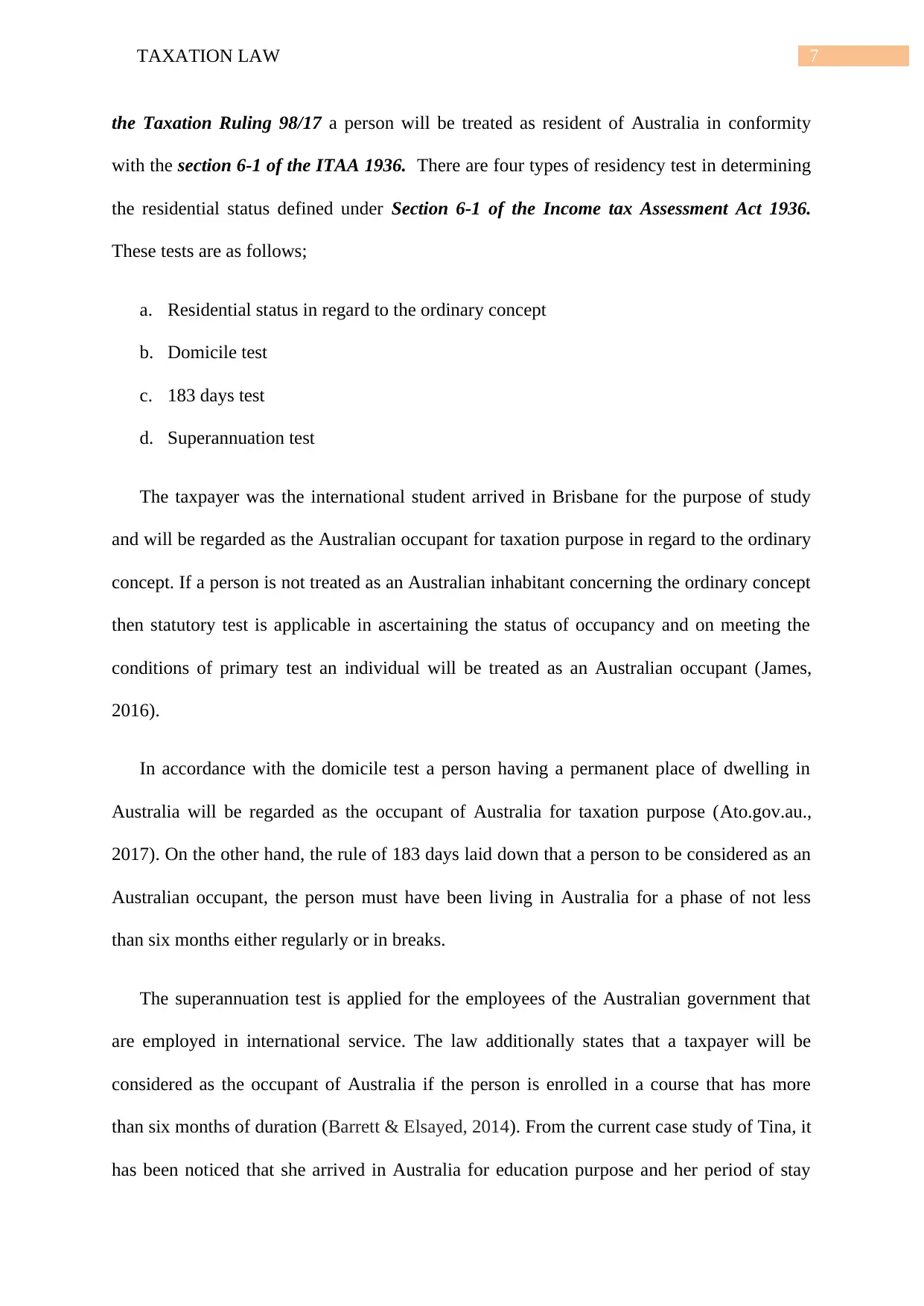
7TAXATION LAW
the Taxation Ruling 98/17 a person will be treated as resident of Australia in conformity
with the section 6-1 of the ITAA 1936. There are four types of residency test in determining
the residential status defined under Section 6-1 of the Income tax Assessment Act 1936.
These tests are as follows;
a. Residential status in regard to the ordinary concept
b. Domicile test
c. 183 days test
d. Superannuation test
The taxpayer was the international student arrived in Brisbane for the purpose of study
and will be regarded as the Australian occupant for taxation purpose in regard to the ordinary
concept. If a person is not treated as an Australian inhabitant concerning the ordinary concept
then statutory test is applicable in ascertaining the status of occupancy and on meeting the
conditions of primary test an individual will be treated as an Australian occupant (James,
2016).
In accordance with the domicile test a person having a permanent place of dwelling in
Australia will be regarded as the occupant of Australia for taxation purpose (Ato.gov.au.,
2017). On the other hand, the rule of 183 days laid down that a person to be considered as an
Australian occupant, the person must have been living in Australia for a phase of not less
than six months either regularly or in breaks.
The superannuation test is applied for the employees of the Australian government that
are employed in international service. The law additionally states that a taxpayer will be
considered as the occupant of Australia if the person is enrolled in a course that has more
than six months of duration (Barrett & Elsayed, 2014). From the current case study of Tina, it
has been noticed that she arrived in Australia for education purpose and her period of stay
the Taxation Ruling 98/17 a person will be treated as resident of Australia in conformity
with the section 6-1 of the ITAA 1936. There are four types of residency test in determining
the residential status defined under Section 6-1 of the Income tax Assessment Act 1936.
These tests are as follows;
a. Residential status in regard to the ordinary concept
b. Domicile test
c. 183 days test
d. Superannuation test
The taxpayer was the international student arrived in Brisbane for the purpose of study
and will be regarded as the Australian occupant for taxation purpose in regard to the ordinary
concept. If a person is not treated as an Australian inhabitant concerning the ordinary concept
then statutory test is applicable in ascertaining the status of occupancy and on meeting the
conditions of primary test an individual will be treated as an Australian occupant (James,
2016).
In accordance with the domicile test a person having a permanent place of dwelling in
Australia will be regarded as the occupant of Australia for taxation purpose (Ato.gov.au.,
2017). On the other hand, the rule of 183 days laid down that a person to be considered as an
Australian occupant, the person must have been living in Australia for a phase of not less
than six months either regularly or in breaks.
The superannuation test is applied for the employees of the Australian government that
are employed in international service. The law additionally states that a taxpayer will be
considered as the occupant of Australia if the person is enrolled in a course that has more
than six months of duration (Barrett & Elsayed, 2014). From the current case study of Tina, it
has been noticed that she arrived in Australia for education purpose and her period of stay
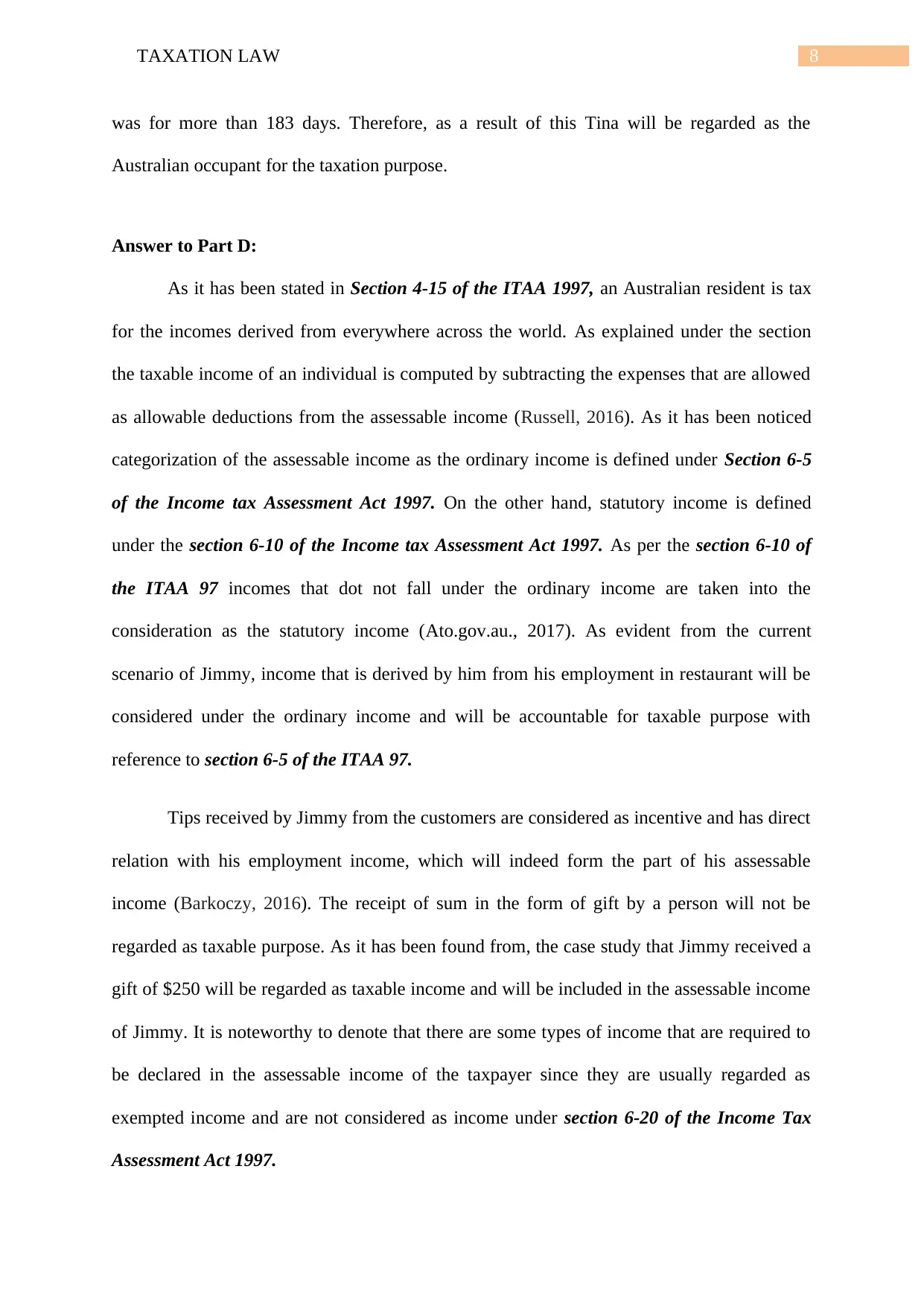
8TAXATION LAW
was for more than 183 days. Therefore, as a result of this Tina will be regarded as the
Australian occupant for the taxation purpose.
Answer to Part D:
As it has been stated in Section 4-15 of the ITAA 1997, an Australian resident is tax
for the incomes derived from everywhere across the world. As explained under the section
the taxable income of an individual is computed by subtracting the expenses that are allowed
as allowable deductions from the assessable income (Russell, 2016). As it has been noticed
categorization of the assessable income as the ordinary income is defined under Section 6-5
of the Income tax Assessment Act 1997. On the other hand, statutory income is defined
under the section 6-10 of the Income tax Assessment Act 1997. As per the section 6-10 of
the ITAA 97 incomes that dot not fall under the ordinary income are taken into the
consideration as the statutory income (Ato.gov.au., 2017). As evident from the current
scenario of Jimmy, income that is derived by him from his employment in restaurant will be
considered under the ordinary income and will be accountable for taxable purpose with
reference to section 6-5 of the ITAA 97.
Tips received by Jimmy from the customers are considered as incentive and has direct
relation with his employment income, which will indeed form the part of his assessable
income (Barkoczy, 2016). The receipt of sum in the form of gift by a person will not be
regarded as taxable purpose. As it has been found from, the case study that Jimmy received a
gift of $250 will be regarded as taxable income and will be included in the assessable income
of Jimmy. It is noteworthy to denote that there are some types of income that are required to
be declared in the assessable income of the taxpayer since they are usually regarded as
exempted income and are not considered as income under section 6-20 of the Income Tax
Assessment Act 1997.
was for more than 183 days. Therefore, as a result of this Tina will be regarded as the
Australian occupant for the taxation purpose.
Answer to Part D:
As it has been stated in Section 4-15 of the ITAA 1997, an Australian resident is tax
for the incomes derived from everywhere across the world. As explained under the section
the taxable income of an individual is computed by subtracting the expenses that are allowed
as allowable deductions from the assessable income (Russell, 2016). As it has been noticed
categorization of the assessable income as the ordinary income is defined under Section 6-5
of the Income tax Assessment Act 1997. On the other hand, statutory income is defined
under the section 6-10 of the Income tax Assessment Act 1997. As per the section 6-10 of
the ITAA 97 incomes that dot not fall under the ordinary income are taken into the
consideration as the statutory income (Ato.gov.au., 2017). As evident from the current
scenario of Jimmy, income that is derived by him from his employment in restaurant will be
considered under the ordinary income and will be accountable for taxable purpose with
reference to section 6-5 of the ITAA 97.
Tips received by Jimmy from the customers are considered as incentive and has direct
relation with his employment income, which will indeed form the part of his assessable
income (Barkoczy, 2016). The receipt of sum in the form of gift by a person will not be
regarded as taxable purpose. As it has been found from, the case study that Jimmy received a
gift of $250 will be regarded as taxable income and will be included in the assessable income
of Jimmy. It is noteworthy to denote that there are some types of income that are required to
be declared in the assessable income of the taxpayer since they are usually regarded as
exempted income and are not considered as income under section 6-20 of the Income Tax
Assessment Act 1997.
⊘ This is a preview!⊘
Do you want full access?
Subscribe today to unlock all pages.

Trusted by 1+ million students worldwide
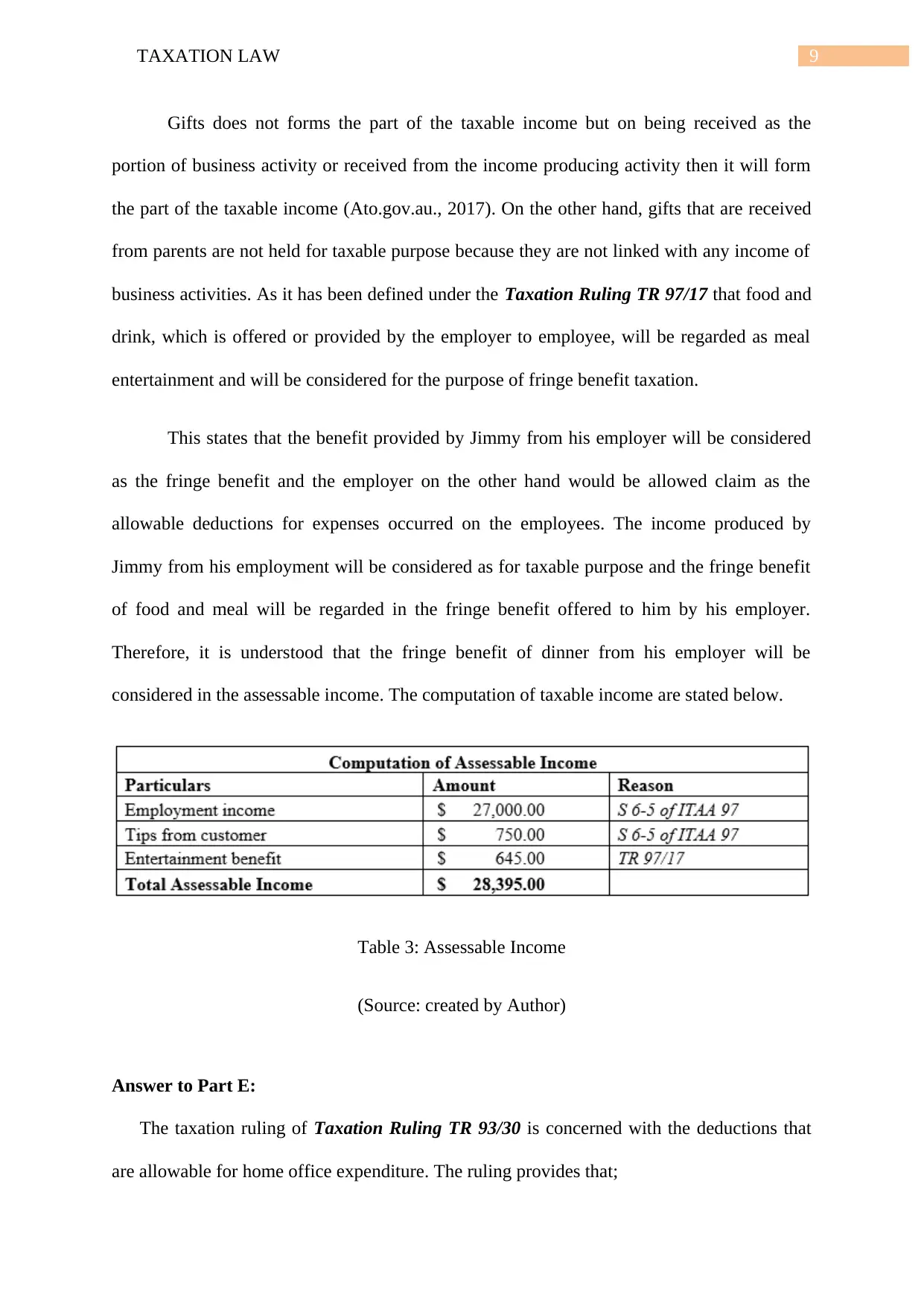
9TAXATION LAW
Gifts does not forms the part of the taxable income but on being received as the
portion of business activity or received from the income producing activity then it will form
the part of the taxable income (Ato.gov.au., 2017). On the other hand, gifts that are received
from parents are not held for taxable purpose because they are not linked with any income of
business activities. As it has been defined under the Taxation Ruling TR 97/17 that food and
drink, which is offered or provided by the employer to employee, will be regarded as meal
entertainment and will be considered for the purpose of fringe benefit taxation.
This states that the benefit provided by Jimmy from his employer will be considered
as the fringe benefit and the employer on the other hand would be allowed claim as the
allowable deductions for expenses occurred on the employees. The income produced by
Jimmy from his employment will be considered as for taxable purpose and the fringe benefit
of food and meal will be regarded in the fringe benefit offered to him by his employer.
Therefore, it is understood that the fringe benefit of dinner from his employer will be
considered in the assessable income. The computation of taxable income are stated below.
Table 3: Assessable Income
(Source: created by Author)
Answer to Part E:
The taxation ruling of Taxation Ruling TR 93/30 is concerned with the deductions that
are allowable for home office expenditure. The ruling provides that;
Gifts does not forms the part of the taxable income but on being received as the
portion of business activity or received from the income producing activity then it will form
the part of the taxable income (Ato.gov.au., 2017). On the other hand, gifts that are received
from parents are not held for taxable purpose because they are not linked with any income of
business activities. As it has been defined under the Taxation Ruling TR 97/17 that food and
drink, which is offered or provided by the employer to employee, will be regarded as meal
entertainment and will be considered for the purpose of fringe benefit taxation.
This states that the benefit provided by Jimmy from his employer will be considered
as the fringe benefit and the employer on the other hand would be allowed claim as the
allowable deductions for expenses occurred on the employees. The income produced by
Jimmy from his employment will be considered as for taxable purpose and the fringe benefit
of food and meal will be regarded in the fringe benefit offered to him by his employer.
Therefore, it is understood that the fringe benefit of dinner from his employer will be
considered in the assessable income. The computation of taxable income are stated below.
Table 3: Assessable Income
(Source: created by Author)
Answer to Part E:
The taxation ruling of Taxation Ruling TR 93/30 is concerned with the deductions that
are allowable for home office expenditure. The ruling provides that;
Paraphrase This Document
Need a fresh take? Get an instant paraphrase of this document with our AI Paraphraser
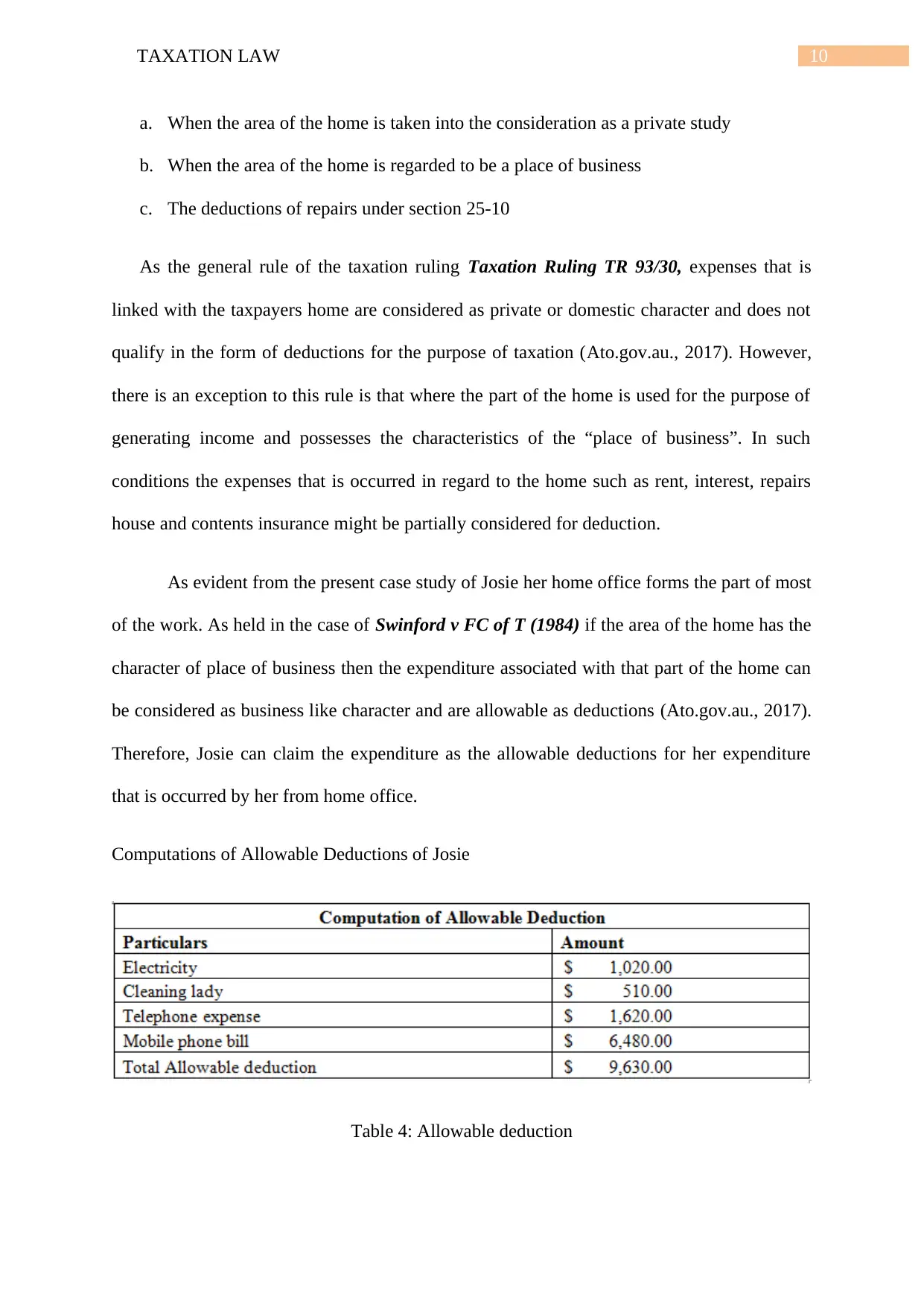
10TAXATION LAW
a. When the area of the home is taken into the consideration as a private study
b. When the area of the home is regarded to be a place of business
c. The deductions of repairs under section 25-10
As the general rule of the taxation ruling Taxation Ruling TR 93/30, expenses that is
linked with the taxpayers home are considered as private or domestic character and does not
qualify in the form of deductions for the purpose of taxation (Ato.gov.au., 2017). However,
there is an exception to this rule is that where the part of the home is used for the purpose of
generating income and possesses the characteristics of the “place of business”. In such
conditions the expenses that is occurred in regard to the home such as rent, interest, repairs
house and contents insurance might be partially considered for deduction.
As evident from the present case study of Josie her home office forms the part of most
of the work. As held in the case of Swinford v FC of T (1984) if the area of the home has the
character of place of business then the expenditure associated with that part of the home can
be considered as business like character and are allowable as deductions (Ato.gov.au., 2017).
Therefore, Josie can claim the expenditure as the allowable deductions for her expenditure
that is occurred by her from home office.
Computations of Allowable Deductions of Josie
Table 4: Allowable deduction
a. When the area of the home is taken into the consideration as a private study
b. When the area of the home is regarded to be a place of business
c. The deductions of repairs under section 25-10
As the general rule of the taxation ruling Taxation Ruling TR 93/30, expenses that is
linked with the taxpayers home are considered as private or domestic character and does not
qualify in the form of deductions for the purpose of taxation (Ato.gov.au., 2017). However,
there is an exception to this rule is that where the part of the home is used for the purpose of
generating income and possesses the characteristics of the “place of business”. In such
conditions the expenses that is occurred in regard to the home such as rent, interest, repairs
house and contents insurance might be partially considered for deduction.
As evident from the present case study of Josie her home office forms the part of most
of the work. As held in the case of Swinford v FC of T (1984) if the area of the home has the
character of place of business then the expenditure associated with that part of the home can
be considered as business like character and are allowable as deductions (Ato.gov.au., 2017).
Therefore, Josie can claim the expenditure as the allowable deductions for her expenditure
that is occurred by her from home office.
Computations of Allowable Deductions of Josie
Table 4: Allowable deduction
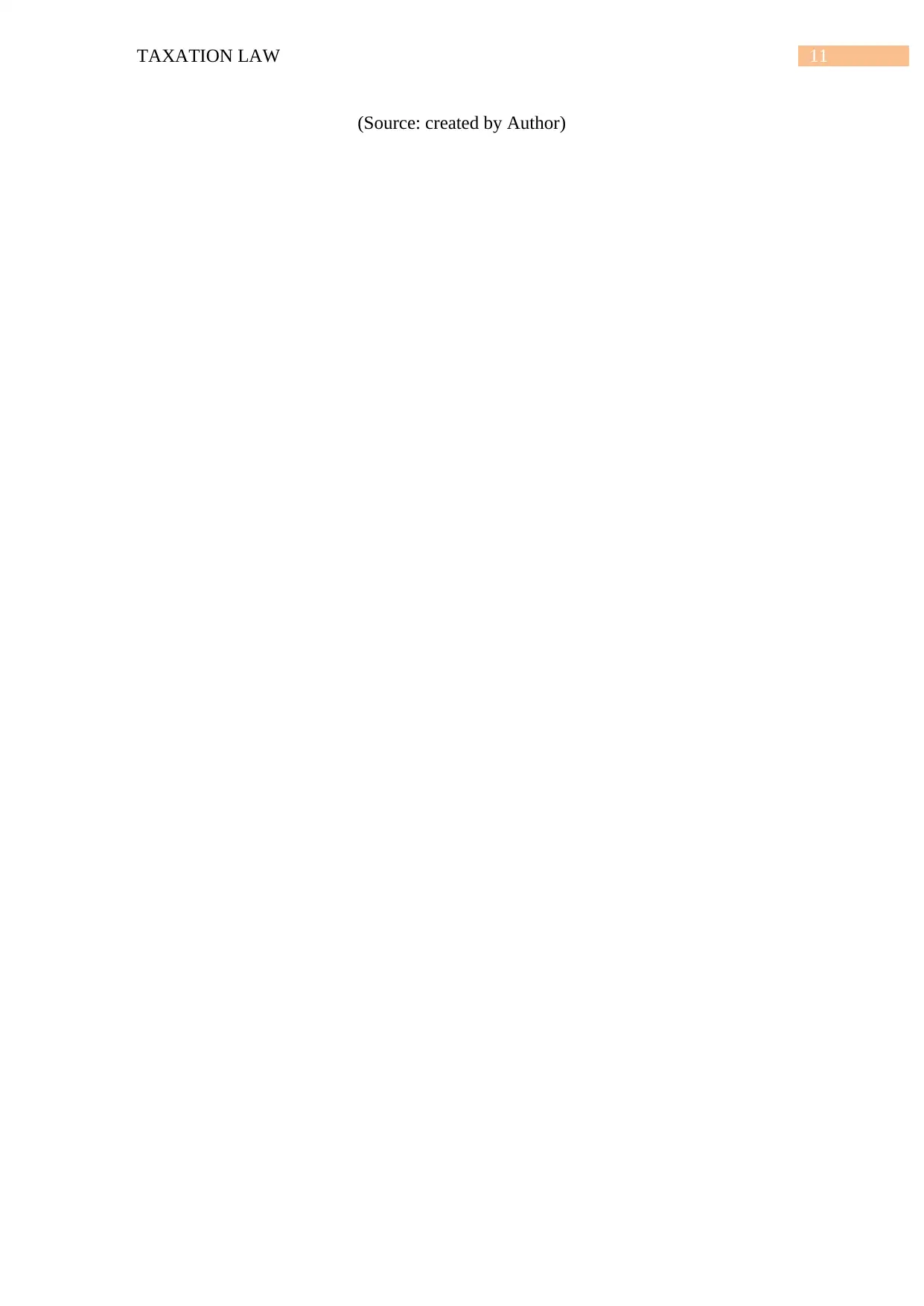
11TAXATION LAW
(Source: created by Author)
(Source: created by Author)
⊘ This is a preview!⊘
Do you want full access?
Subscribe today to unlock all pages.

Trusted by 1+ million students worldwide
1 out of 15
Related Documents
Your All-in-One AI-Powered Toolkit for Academic Success.
+13062052269
info@desklib.com
Available 24*7 on WhatsApp / Email
![[object Object]](/_next/static/media/star-bottom.7253800d.svg)
Unlock your academic potential
Copyright © 2020–2025 A2Z Services. All Rights Reserved. Developed and managed by ZUCOL.





